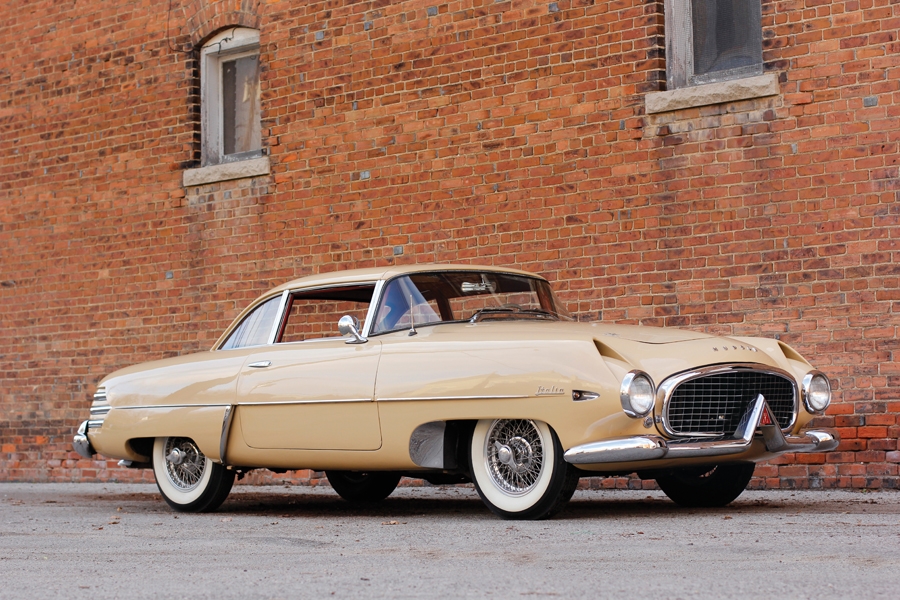- One of only 26 examples produced and one of just 21 remaining
- Powered by its original engine and equipped with overdrive
- Outstanding driver, tour- and road-ready
- Carefully inspected and extensively serviced by Mr. Ed Souers, Hudson Italia Historian for the Hudson Essex Terraplane Club and Manager of the National Hudson Motor Car Company Museum in Ypsilanti, MI
SCM Analysis
Detailing
| Vehicle: | 1955 Hudson Italia |
| Years Produced: | 1955 |
| Number Produced: | 25 (plus one prototype) |
| Original List Price: | $4,800 |
| SCM Valuation: | Median to date, $240,000; high sale, $396,000 |
| Tune Up Cost: | $150 |
| Distributor Caps: | $35 |
| Chassis Number Location: | Firewall and stamping under passenger’s carpet |
| Engine Number Location: | Upper right front side of block |
| Club Info: | Hudson Essex Terraplane Club |
| Website: | www.HETClub.org |
| Alternatives: | 1956–58 Dual-Ghia, 1953–55 Chevrolet Corvette, 1955–57 Ford Thunderbird |
| Investment Grade: | B |
This car, Lot 38, sold for $242,000, including buyer’s premium, at Worldwide’s Houston Classic Auction in Houston, TX, on April 23, 2016.
From humble start to cutting edge
The Hudson Motor Car Company was founded on February 20, 1909, and was named for Joseph L. Hudson of Detroit department-store fame. Hudson, one of several stockholders, was named as the first president, but he took little interest in the firm. Their objective was to build “a small, low-cost car of quality,” and their first cars were priced at only $50 above the new Model T Ford.
Business prospered until the Great Depression, but Hudson survived with the introduction of the “Great Eight” and the high-performance Terraplane. In the early ’30s, Hudson held every AAA hillclimb record for stock cars, and the Terraplane set 12 Class C records at Daytona.
World War II, of course, brought automotive production to a standstill. But when manufacturing resumed, Hudson was well prepared with an innovative “Monobuilt” construction method, which allowed for the passenger’s footwells to sit below the frame. The distinctive “stepdown” Hudson handled better than anything on the market. The Super Six became the Hornet in 1951, and with the “Twin-H” dual-carburetor package, it ruled NASCAR for several years.
Hudson Chief Designer Frank Spring was given the assignment to develop the follow-on Jet, but financial restraints and top management’s meddling resulted in an outcome that was boxy and homely. Spring was so distraught that he threatened to leave but was placated with the opportunity to design an experimental sports car that would test public reaction to some radical concepts that might be incorporated in later designs.
American Hudson, Italian body
Spring worked with Carlo Felice Bianchi Anderloni, chief designer of Touring Body Works of Milan, Italy, using the Jet chassis, to develop an all-aluminum design that could be presented at the Detroit Auto Show in December 1953. It was also aimed at the Carrera Panamericana, where Marshall Teague had recently finished a remarkable 6th in a Hudson Hornet. Some sources claim 50 of the “Super Jets” were commissioned from Touring, but it is more likely only 25 were ordered, perhaps for homologation for the American Class of the Mexican La Carrera road race.
The resulting swoopy Hudson Italia was 10 inches lower than the Jet and weighed less than 3,000 pounds. It was claimed that it was capable of over 100 miles per hour. The flamboyant styling featured an inverted “V” front bumper, large faux-cooling “V” scooped vents on the front fenders, and three stacked chrome tubes on the rear fenders that contained the brake, reverse and turn-signal lights. Another of Spring’s unique design features was a door that extended well into the roofline to ease entry.
The cars were powered by the Jet six with Twin-H carburation. The engine produced 115 horsepower, which drove through Hudson’s smooth-shifting 3-speed manual transmission. All the cars were finished in “Italian Cream” with red and cream leather interior and a crinkle-finish dash. They were priced at $4,800, although it was reported that each cost Hudson $28,000 to build.
All in the timing
The Italia could have not been introduced at a worse time. When production began, Hudson was on the verge of bankruptcy and was merging — or was being taken over — by Nash-Kelvinator to form American Motors. An exotic car that was receiving little interest at dealer showrooms and was generating a sizable loss was difficult to justify to the new American Motors management. Sales Manager Roy Chapin was ordered to “get rid of those cars.”
Of the 26 Italias constructed, 21 are thought to still exist. Even with limited production, they appear at public auction with regularity. Gooding & Company, at their 2015 Pebble Beach auction, sold a “barn find,” which was lacking its motor and transmission, for $154,000 (ACC# 266289). A year earlier, at Scottsdale, Gooding sold an example with 26,000 miles for $330,000 (ACC# 241451). Barrett-Jackson sold well-restored chassis 1002 for $396,000 in Scottsdale in 2013 (ACC# 214843). That car had once been owned by racing driver Lance Reventlow. And RM Auctions, at their 2012 Monterey sale, sold chassis 10011 for $265,000 (ACC# 209612).
Based on the extensive catalog photographs, it would appear that this Italia sold by Worldwide was complete but wore an older restoration that was starting to unwind a bit. Based, however, on the price paid, the new owner has room to write a couple of decent-sized checks to bring it up to snuff and still be on the right side of the ledger. As such, I’ll call this a fair deal for all concerned.
(Introductory description courtesy of Worldwide Auctioneers.)
